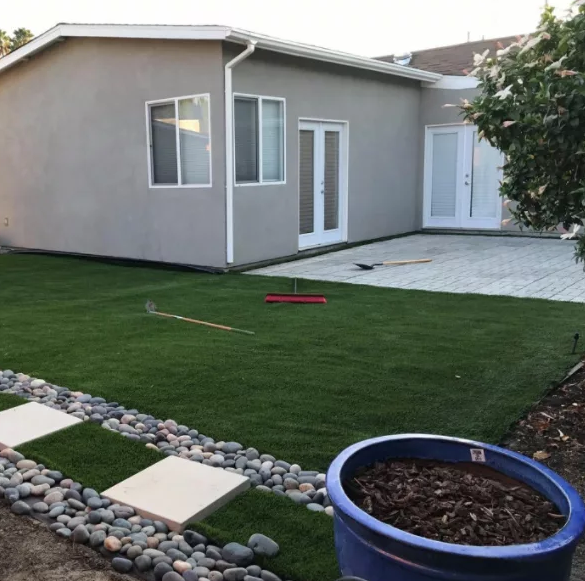Artificial grass, also known as synthetic turf or fake grass, has gained immense popularity in recent years. Its low maintenance requirements and year-round green appearance make it an attractive option for homeowners and businesses alike. Whether you’ve recently installed artificial grass or are considering making the switch, proper maintenance is key to ensuring it looks lush and stays in pristine condition for years to come. In this blog, we will explore the essential steps to maintain artificial grass and keep it looking its best.
Regular Cleaning
Keeping your artificial grass clean is the first step to maintaining its vibrant appearance. Here are a few tips on how to do it:
a. Sweeping: Use a stiff broom or brush to sweep away leaves, debris, and loose dirt. Regular sweeping helps prevent the accumulation of debris, which can harbor pests and create an unattractive appearance.
b. Rinsing: Occasionally, give your artificial grass a good rinse with a hose. This will help remove dust and small particles. Be sure to rinse it gently to avoid disrupting the infill material underneath.
c. Pet Waste: If you have pets, promptly remove solid waste and rinse the area with water to prevent odors and ensure cleanliness. Use a pet-friendly enzyme cleaner to break down any residual odors.
d. Stains: For tough stains like oil, grease, or paint, use a mild detergent and water. Gently scrub the area with a soft brush and rinse thoroughly. Avoid using harsh chemicals, as they can damage the synthetic fibers.
Brushing and Fluffing
Over time, foot traffic and weather conditions can cause the synthetic grass blades to flatten. To maintain its natural look, use a stiff brush with synthetic bristles to fluff up the grass fibers. Brush against the grain to encourage the blades to stand upright. This process should be done periodically, especially in high-traffic areas, to prevent matting and ensure a lifelike appearance.
Weed Control
One of the significant advantages of artificial grass is that it minimizes weed growth. However, weeds can still emerge along the edges or through the infill. To keep weeds at bay:
a. Install a weed barrier during the installation process to inhibit weed growth from below.
b. Regularly inspect the edges and seams of your artificial grass for any weed intrusion. If you spot any, pull them out and apply a weed killer to prevent regrowth.
c. Applying a weed membrane around the perimeter of your artificial grass can help further deter weed growth.
Infill Maintenance
Infill plays a crucial role in supporting the artificial grass blades and providing stability. The most common types of infill are silica sand and rubber granules. To ensure your infill remains effective, consider these maintenance tips:
a. Periodically top up the infill material if it appears compacted or has been displaced due to heavy use or extreme weather conditions.
b. Gently rake or brush the infill to redistribute it evenly across the entire surface, preventing uneven wear and tear.
Protecting Your Artificial Grass
Artificial grass is relatively low-maintenance, but some precautions can help prolong its lifespan:
a. Be cautious with heavy objects: Avoid placing heavy furniture or objects on your artificial grass for extended periods, as this can lead to permanent indentations or damage the fibers.
b. Use a buffer for high-traffic areas: If you have areas that receive frequent use, like a pathway or a play area, consider using stepping stones or artificial grass mats to protect those areas from excessive wear.
c. Watch for reflective surfaces: Be aware of reflective surfaces such as windows that can concentrate sunlight and potentially melt the grass. Using shade or protective window films can prevent this issue.
Seasonal Care
Artificial grass requires different care in different seasons:
a. Spring: Spring cleaning should involve thorough brushing, infill top-up, and weed control. Inspect the grass for any damage caused by winter weather.
b. Summer: Maintain a regular cleaning schedule to keep the grass looking fresh. Avoid using barbecues or fire pits directly on the artificial grass to prevent heat damage.
c. Fall: Stay on top of leaf removal to prevent them from decaying and creating a breeding ground for pests. Ensure proper drainage to avoid waterlogging in the rainy season.
d. Winter: Although artificial grass is suitable for winter conditions, you should brush away snow to prevent it from compacting and causing damage.
Professional Maintenance
While most artificial grass maintenance can be handled by homeowners, it’s a good idea to schedule occasional professional maintenance to ensure your lawn’s longevity. Professionals can perform tasks like deep cleaning, infill rejuvenation, and spot repairs. This expert care can help extend the lifespan of your artificial grass and keep it looking its best.
Conclusion
Artificial grass provides a beautiful, low-maintenance alternative to natural grass, offering a green and lush lawn year-round. By following the maintenance tips outlined in this blog, you can enjoy the benefits of artificial grass for many years to come. Regular cleaning, brushing, weed control, infill maintenance, and seasonal care are essential for preserving the aesthetics and functionality of your artificial grass. With the right care, your synthetic lawn will remain an attractive, hassle-free addition to your home or business.
While artificial grass is much easier to maintain than natural grass, homeowners should still perform regular artificial grass maintenance to keep their turf in top shape. Thankfully, you won’t need a lawnmower for basic turf maintenance!
Natural vs. Artificial Grass: Differences in Care Requirements
Artificial grass is exactly as its name suggests: artificial. The highest quality artificial turf is made from synthetic fibers which, while almost identical to natural grass, don’t require weeding, watering, or mowing.
However, artificial grass still requires basic maintenance. Like a rug or carpet, artificial turf picks up dirt and debris over time. As a result, turf maintenance usually comes down to basic cleaning.
Tips on How to Clean Artificial Turf
For the best appearance and lifespan, regularly perform these easy turf maintenance tasks:
- Keep artificial grass clean of debris and dirt using artificial grass maintenance equipment such as a rake, leaf blower, broom, and/or brush as needed. For the best clean, use an artificial grass maintenance brush with bristles at least five inches long.
- Use a hose to spray away dust as needed. Regular hosing will also help maintain the turf’s sheen, ensuring the best appearance.
- Clean stains with water and a mild detergent. Since the material is synthetic, stains will usually come out easily.
Finding Low-Maintenance Artificial Grass
Some types of fake grass are easier to clean than others. For the highest quality synthetic grass with the lowest maintenance, explore our product line or call 1-877-262-4145 to speak with one of our experts.



